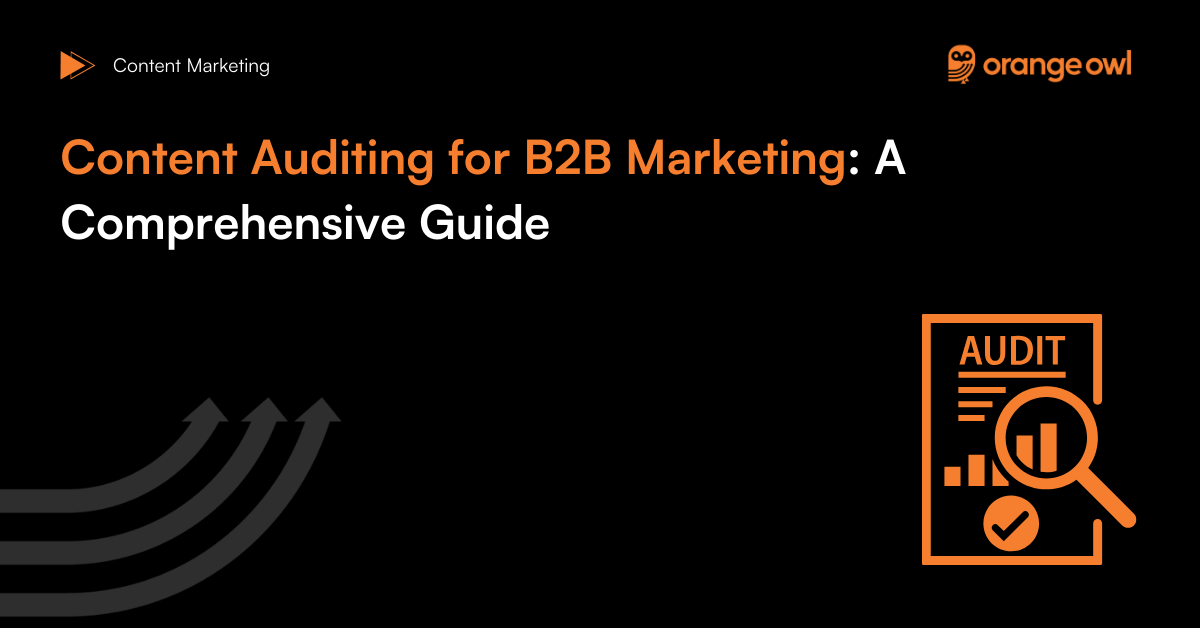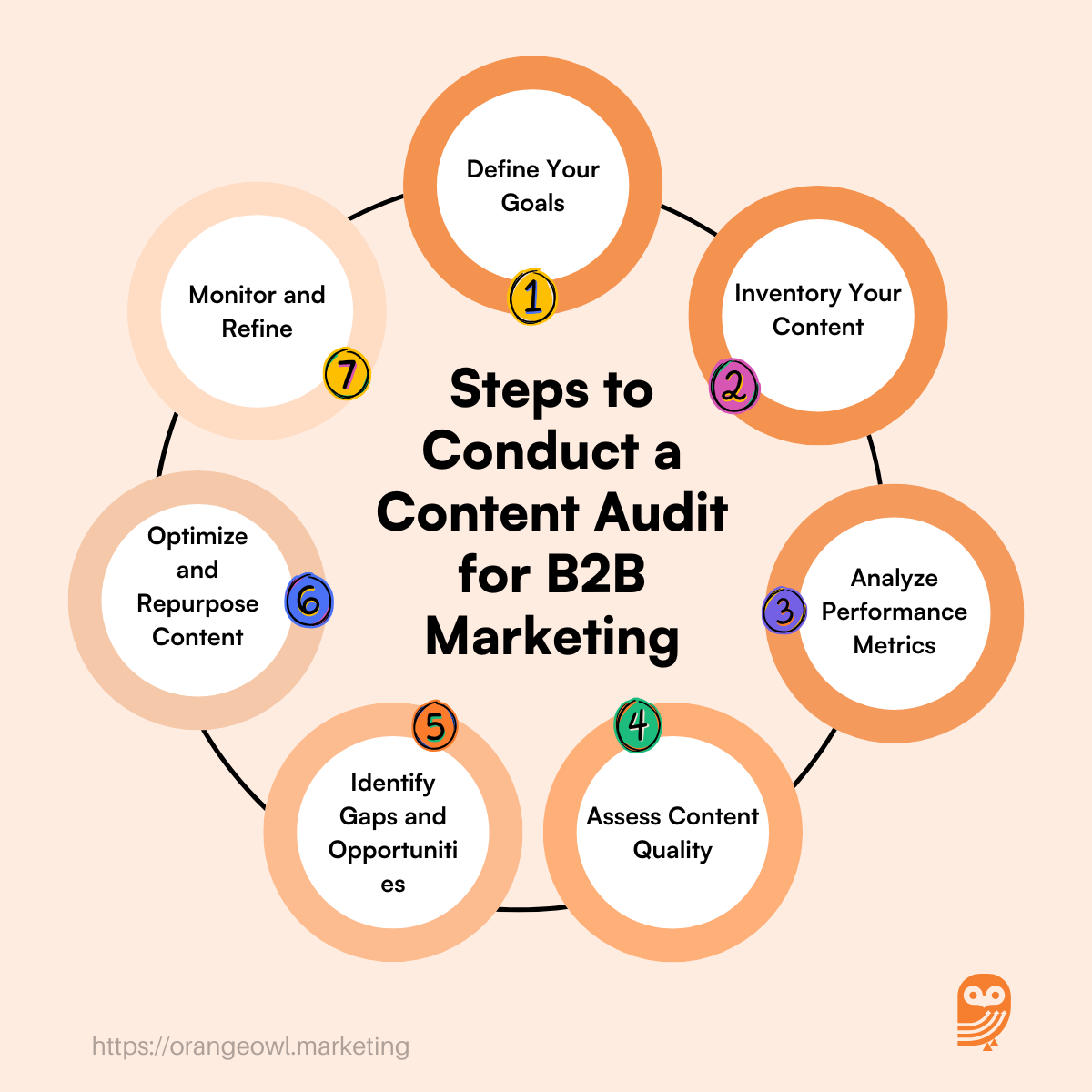Content Auditing for B2B Marketing: A Comprehensive Guide
Vivek Goel
February 10, 2025

Table of Contents
Introduction
Content Auditing is a critical process for B2B marketers aiming to optimize their content strategy, improve engagement, and drive conversions. According to Semrush, 65% of successful B2B marketers conduct content audits at least twice a year, leading to higher lead generation and better ROI. A well-executed content auditing process helps businesses assess the effectiveness of existing content, identify gaps, and refine their approach to align with business goals. Research also shows that companies that regularly audit their content experience a 30% increase in organic traffic. This guide walks you through the steps to perform a successful content auditing process for B2B marketing.
Why is Content Auditing Important for B2B Marketing?
Unlike B2C marketing, where impulse purchases and emotional appeals drive sales, B2B content marketing focuses on longer sales cycles, multiple decision-makers, and highly informative content. This makes Content Auditing crucial for ensuring content remains relevant, engaging, and aligned with business objectives.
A well-structured content auditing process helps businesses in several ways:
1. Identify Underperforming Content
Not all content delivers the desired results. Some blog posts, whitepapers, or case studies may have low traffic, high bounce rates, or poor engagement. By analyzing performance metrics, businesses can update, repurpose, or remove outdated content.
Example: HubSpot discovered that 92% of their blog leads came from old posts. By auditing and updating these posts with fresh data and improved SEO, they doubled their inbound traffic within six months.
Case Study: Moz audited their blog content and identified posts with declining traffic. By optimizing them with new insights, they increased organic traffic by 30% in a year.
2. Ensure Consistency in Messaging and Brand Voice
B2B marketing often involves multiple stakeholders creating content—marketers, product teams, and sales teams. Without a structured content auditing process, inconsistencies in tone, messaging, and branding can confuse potential customers.
Example: A SaaS company targeting enterprises found that different blog articles used inconsistent terminology for the same features. By standardizing language across all content, they improved brand recall and trust among customers.
Case Study: Salesforce streamlined its content by conducting a messaging audit, ensuring that all blog posts, case studies, and product pages followed a unified tone. This resulted in a 15% increase in engagement and better conversion rates.
3. Improve SEO Rankings
B2B buyers heavily rely on organic search to research solutions before making purchasing decisions. An SEO-focused content audit identifies outdated keywords, broken links, and duplicate content that may be hurting search rankings.
Example: A manufacturing company noticed declining rankings for its key product pages. By optimizing metadata, fixing broken links, and updating outdated industry statistics, they saw a 50% increase in organic leads within three months.
Case Study: Ahrefs audited its blog and discovered keyword cannibalization issues (where multiple pages competed for the same keyword). By consolidating content and improving internal linking, they boosted page one rankings by 40%.
4. Align Content with Customer Journey Stages
B2B buyers go through distinct phases—awareness, consideration, and decision-making. A content auditing process ensures that the right type of content is available for each stage.
Example: A cybersecurity firm found that 90% of its blog traffic came from awareness-stage content, but lead conversions were low. By adding middle- and bottom-of-funnel content such as comparison guides, case studies, and product demos, they increased qualified leads by 35%.
Case Study: Adobe mapped its existing content to customer journey stages. By identifying gaps and creating new content tailored to decision-makers, they increased enterprise customer engagement by 20%.
5. Enhance Lead Generation and Conversion Rates
Outdated or irrelevant content can cause leads to drop off before they convert. A content auditing process ensures high-value content is optimized for lead capture, nurturing, and conversion.
Example: A B2B SaaS company had several high-traffic blog posts but low lead generation. By adding interactive tools, gated content, and strategic CTAs, they saw a 3X increase in demo sign-ups.
Case Study: IBM conducted a content audit on its resource hub and found that some whitepapers had high traffic but low downloads. By simplifying forms and adding chatbot support, they boosted conversion rates by 25%.
Methods of Content Auditing
There are various methods to conduct a content auditing process effectively. The right approach depends on your goals—whether it’s improving SEO, increasing engagement, or refining messaging. Below are some commonly used content auditing methods, along with actionable tips to maximize their impact.
1. Quantitative Analysis
Focus: Uses numerical data to assess content performance.
Metrics to Track:
Traffic & Page Views – Identify which pages drive the most traffic using Google Analytics.
Bounce Rate – High bounce rates may indicate poor user experience or irrelevant content.
Dwell Time – The time users spend on a page indicates content value.
Conversion Rate – Tracks how well content drives leads, form submissions, or sales.
Actionable Tips:
✔ Identify High-Performing Content: Find top-performing pages and analyze their structure, CTA placement, and format. Replicate these elements in underperforming content.
✔ Optimize Low-Performing Content: If a blog post has high traffic but low conversions, add clearer CTAs, testimonials, or lead magnets.
✔ Use Heatmaps: Tools like Hotjar show where users click or drop off, helping you improve readability and engagement.
Example: A SaaS company found that 20% of their blog posts generated 80% of inbound leads. By optimizing CTA placement in low-performing articles, they boosted conversions by 25%.
2. Qualitative Analysis
Focus: Reviews content for relevance, accuracy, readability, and brand alignment.
Key Areas to Evaluate:
Content Clarity & Readability – Use Hemingway Editor or Grammarly to check sentence structure and readability.
Brand Consistency – Ensure the tone, style, and messaging align with brand guidelines.
Relevance & Accuracy – Outdated statistics, broken links, or irrelevant references hurt credibility.
Actionable Tips:
✔ Refresh Outdated Content: Update statistics, case studies, and references to keep content relevant.
✔ Ensure Brand Voice Consistency: Create a content style guide to standardize terminology, tone, and messaging.
✔ Gather Stakeholder Feedback: Get input from sales, customer support, and leadership to ensure content addresses key customer pain points.
Example: A financial services firm found that their whitepapers used inconsistent terminology across different product lines. By standardizing the language, they improved brand trust and user comprehension.
3. SEO Audit
Focus: Optimizes content for search engines and organic visibility.
Key SEO Elements to Check:
Keyword Optimization – Ensure target keywords are naturally integrated.
Meta Titles & Descriptions – Improve click-through rates by writing compelling meta descriptions.
Internal & External Links – Strengthen SEO by linking relevant pages within your site and authoritative external sources.
Mobile Friendliness – Use the Google Mobile-Friendly Test to ensure accessibility.
Actionable Tips:
✔ Fix Keyword Cannibalization: If multiple pages compete for the same keyword, consolidate them into a single authoritative piece.
✔ Optimize Old Content: Refresh old blog posts with new keywords, updated data, and improved formatting.
✔ Improve Page Speed: Use Google PageSpeed Insights to fix slow-loading pages that affect rankings.
Example: A B2B tech company updated its product landing pages with better internal linking and keyword optimization, leading to a 40% increase in organic traffic.
4. Competitor Benchmarking
Focus: Evaluate competitors’ content strategies to identify strengths, weaknesses, and opportunities.
What to Analyze:
Top-Performing Content – Identify which topics drive the most engagement.
Content Formats – Determine whether competitors use videos, case studies, webinars, or whitepapers effectively.
SEO Strategies – Check keyword usage, backlinks, and ranking content using Ahrefs or SEMrush.
Gaps & Opportunities – Look for areas where competitors are lacking or where you can differentiate.
Actionable Tips:
✔ Use Content Gap Analysis: Find high-performing topics competitors rank for, but you don’t, and create content around them.
✔ Analyze Their Engagement Strategies: If competitors get high engagement on social media, study their post frequency, CTA placement, and content style.
✔ Differentiate Your Content: Instead of copying competitors, offer unique insights, case studies, or interactive elements.
Example: A logistics company found that competitors had few case studies. By creating in-depth success stories, they gained industry authority and increased leads by 20%.
5. Audience Engagement Analysis
Focus: Measures how well content resonates with the target audience.
Key Metrics to Track:
Social Shares & Comments – High shares indicate content value.
Time Spent on Page – If users leave quickly, content may not be engaging enough.
Scroll Depth – Tools like Crazy Egg help track how far users scroll.
User Feedback – Direct feedback from customers or surveys can provide insights.
Actionable Tips:
✔ Find High-Engagement Content: Identify which topics drive the most social interactions and create more similar content.
✔ Experiment with Different Formats: If blog posts get low engagement, try repurposing them into infographics, videos, or podcasts.
✔ Add Interactive Elements: Polls, quizzes, and calculators increase engagement and dwell time.
Example: A cybersecurity firm noticed their long-form blogs had low engagement. After breaking them into shorter posts with visuals, social shares increased by 50%.
Methods of Content Testing
Content testing is essential for ensuring engagement, readability, and conversion success before and after publishing. Businesses can refine content strategies and maximize audience impact by using various testing methods. Below are key content testing methods, along with actionable tips for implementation.
1. A/B Testing
Focus: Compares two variations of content to measure which one performs better in terms of engagement, click-through rates, or conversions.
What to Test:
Headlines & Titles – Test different versions to see which generates higher clicks.
CTA Placement & Wording – Experiment with CTA button color, size, and phrasing.
Content Format & Length – Compare short-form vs. long-form content effectiveness.
Visuals & Layout – Test different images, bullet points, or paragraph structures.
Actionable Tips:
✔ Test One Variable at a Time: If testing headlines, keep the rest of the content identical.
✔ Use A/B Testing Tools: Platforms like Google Optimize, HubSpot, or Optimizely help automate split testing.
✔ Analyze Results Over Time: Run tests for at least two weeks to gather meaningful insights.
Example: A SaaS company tested two email subject lines—one direct and one curiosity-driven. The curiosity-based subject increased open rates by 27%.
2. User Feedback
Focus: Gathers direct insights from audiences to improve content quality and relevance.
How to Collect Feedback:
Surveys & Polls – Ask readers what they find valuable or confusing.
Comment Sections – Monitor user questions and reactions.
Live Chat or Customer Support Data – Analyze recurring content-related inquiries.
Beta Testing with Focus Groups – Conduct controlled testing with small user groups before full release.
Actionable Tips:
✔ Keep Surveys Short & Specific: Ask 3-5 targeted questions to improve response rates.
✔ Look for Patterns in Feedback: If multiple users mention readability issues, adjust content complexity.
✔ Follow Up for Deep Insights: Engage with respondents to understand why they feel a certain way.
Example: A B2B cybersecurity firm gathered user feedback and found that their whitepapers were too technical. Simplifying language led to 35% higher downloads.
3. Heatmaps
Focus: Visual analytics is used to track user interaction with content.
What Heatmaps Reveal:
Scroll Depth: How far users read before leaving the page.
Click Patterns: Which links, buttons, or CTAs attract the most interaction.
Dead Zones: Areas where users don’t engage at all.
Actionable Tips:
✔ Use Heatmap Tools: Platforms like Hotjar, Crazy Egg, or Microsoft Clarity provide user interaction reports.
✔ Identify Drop-Off Points: If users leave before key CTAs, reposition them higher on the page.
✔ Optimize Based on User Behavior: If most engagement happens around bullet points, use them more frequently.
Example: An e-commerce site found that users ignored the sidebar menu but engaged more with in-content links. Removing the sidebar and optimizing in-text CTAs increased click-through rates by 40%.
4. Readability Tests
Focus: Ensures content is clear, concise, and easy to understand.
Best Tools for Readability Testing:
Hemingway Editor – Highlights complex sentences and passive voice.
Grammarly – Provides readability and clarity suggestions.
Flesch-Kincaid Score – Measures reading difficulty based on sentence structure and word choice.
Actionable Tips:
✔ Aim for a Flesch-Kincaid Score of 60+ (for easy readability).
✔ Use Short Sentences & Simple Words: Avoid industry jargon unless necessary.
✔ Break Up Long Paragraphs: Use bullet points, subheadings, and white space for better readability.
Example: A fintech blog simplified its long, technical articles using Hemingway Editor. Readability improvements led to a 22% increase in session duration.
5. SEO Performance Testing
Focus: Measures how well content ranks and adjusts strategies for improved search visibility.
Key Metrics to Track:
Keyword Rankings – Monitor position changes for target keywords.
Click-Through Rate (CTR) – Measure how often people click on search results.
Organic Traffic Growth – Analyze increases or drops in visits from search engines.
Backlink Profile – Track how many external sites link to the content.
Actionable Tips:
✔ Use SEO Testing Tools: Platforms like Google Search Console, SEMrush, and Ahrefs provide ranking insights.
✔ Optimize Meta Descriptions: Craft compelling descriptions to boost CTR.
✔ Refresh Old Content: Update stats, keywords, and internal links to maintain rankings.
Example: A B2B software company tested two meta descriptions for a case study page. The one emphasizing “Proven 50% Cost Savings” had a 34% higher CTR than the generic version.
Steps to Conduct a Content Audit for B2B Marketing
1. Define Your Goals
Before diving into an audit, establish clear objectives. Some common goals include:
Increasing website traffic
Generating quality leads
Enhancing customer engagement
Improving search engine visibility
2. Inventory Your Content
Gather all content assets, including blog posts, whitepapers, case studies, landing pages, and social media posts. Categorize them based on content type, format, and distribution channels.
3. Analyze Performance Metrics
Use tools like Google Analytics, SEMrush, and HubSpot to track key metrics such as:
Page views
Bounce rate
Time on page
Conversion rates
Keyword rankings
4. Assess Content Quality
Evaluate content based on:
Relevance: Is the content aligned with your audience’s needs?
Accuracy: Is the information up to date and factually correct?
Engagement: Does the content encourage interaction and shareability?
Brand Consistency: Is the tone and voice consistent with your brand?
5. Identify Gaps and Opportunities
Determine where content gaps exist in your buyer’s journey. Consider:
Missing content for certain customer personas
Lack of content for specific funnel stages (awareness, consideration, decision)
Topics that need updating or expansion
6. Optimize and Repurpose Content
Instead of creating new content from scratch, optimize and repurpose high-performing content. Strategies include:
Updating outdated blog posts with new statistics
Converting blog posts into infographics or videos
Republishing evergreen content on LinkedIn or industry forums
7. Implement Actionable Changes
Develop an action plan based on audit insights. Assign responsibilities, set deadlines, and implement SEO improvements, content updates, or repurposing strategies accordingly.
8. Monitor and Refine
Content auditing is an ongoing process. Schedule regular audits (quarterly or bi-annually) to keep content fresh, relevant, and impactful.
Conclusion:
A well-structured content auditing process is essential for B2B marketers aiming to optimize their content marketing strategy, boost audience engagement, and drive business growth. By systematically assessing content performance, relevance, and alignment with business goals, companies can identify opportunities for improvement and ensure maximum ROI on their content efforts.
However, a content audit alone isn’t enough—it must be followed by rigorous content testing to validate improvements and measure real-world impact. Content testing helps refine messaging, optimize user experience, and enhance conversion rates by ensuring that every piece of content resonates with the target audience.
Frequently Asked Questions (FAQs) about Content Auditing
A content audit is a systematic review of all content assets to assess their effectiveness, optimize performance, and align with business goals in a B2B marketing strategy.
It helps identify underperforming content, improve SEO rankings, maintain brand consistency, and enhance lead generation efforts.
Ideally, businesses should conduct content audits quarterly or bi-annually to ensure content remains relevant and effective.
Popular tools include Google Analytics, SEMrush, HubSpot, Screaming Frog, and Hotjar for assessing content performance and engagement.
Content can be categorized based on format (blog posts, case studies, videos), customer journey stages, performance metrics, and engagement levels.
Metrics include page views, bounce rate, time on page, conversion rate, keyword rankings, and social shares.
Content auditing evaluates existing content, while content testing involves experimenting with new content strategies (e.g., A/B testing) to measure effectiveness.
Outdated content can be updated with new data, repurposed into different formats (e.g., infographics, videos), and improved for SEO performance.
Competitor benchmarking helps businesses identify gaps in their content strategy, uncover new trends, and refine their approach based on industry standards.
By ensuring that content aligns with the buyer’s journey, improving SEO, and enhancing engagement, content auditing helps attract and convert high-quality leads.



